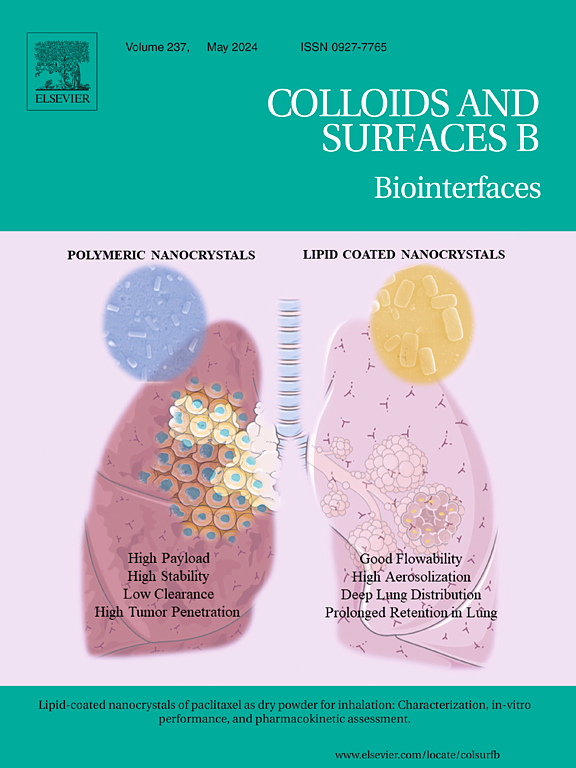Enhancing thrombolysis through targeted delivery of urokinase by H2O2-responsive nanoparticles delivery system
IF 5.4
2区 医学
Q1 BIOPHYSICS
引用次数: 0
Abstract
Thrombotic diseases, such as stroke and myocardial infarction, represent significant threats to global health. Timely and safe thrombolysis is crucial in improving tissue ischemia and preventing thrombosis progression. Urokinase (UK) is a widely used thrombolytic agent, however, its clinical use is constrained by bleeding risks and other adverse effects. In this study, EGCG-Mn-Fuc nanoparticles with H2O2 responsiveness were successfully prepared. Urokinase was loaded into the nanomaterials via the direct assembly method, and the thrombolytic effect of these nanoparticles was investigated. The preparation process of the nanoparticles is straightforward, and the reaction conditions are relatively mild. The physical and chemical properties of the EGCG-Mn-Fuc nanoparticles were characterized by means of dynamic light scattering (DLS), transmission electron microscopy (TEM), fourier transform infrared spectroscopy (FTIR), Ultraviolet and visible spectrum (UV-Vis) and X-ray photoelectron spectroscopy (XPS). In cell experiments, EGCG-Mn-Fuc nanoparticles showed low cytotoxicity and good biocompatibility. Furthermore, these nanoparticles effectively scavenged DPPH free radicals, attributing this capability primarily to their antioxidant properties. In vitro thrombolytic experiments showed that EGCG-Mn-Fuc nanoparticles intelligently responded to H2O2, releasing the loaded urokinase and exerting a thrombolytic effect. The microcapsules exhibited concentration-dependent thrombolytic effects, effectively dissolving thrombi in the presence of H2O2. Hemolysis and coagulation tests confirmed their good blood compatibility and anticoagulant properties. In addition, it is worth noting that the nanoparticle contains fucoidan that mimics P-selectin glycoprotein ligand-1(PSGL-1) and has a high affinity for activating P-selectin on the surface of platelets. Overall, the results of this study not only provide valuable experimental evidence and theoretical support for the application of EGCG-Mn-Fuc nanoparticles in the field of thrombolysis, but also establish a foundation for the biomedical application of drug carriers in this field.
通过h2o2响应纳米颗粒递送系统靶向递送尿激酶增强溶栓
血栓性疾病,如中风和心肌梗死,对全球健康构成重大威胁。及时、安全的溶栓对改善组织缺血、防止血栓形成至关重要。尿激酶(UK)是一种广泛使用的溶栓药物,然而,其临床应用受到出血风险和其他不良反应的限制。本研究成功制备了具有H2O2响应性的EGCG-Mn-Fuc纳米颗粒。通过直接组装的方法将尿激酶装入纳米材料中,并研究了这些纳米材料的溶栓作用。纳米颗粒的制备过程简单,反应条件相对温和。采用动态光散射(DLS)、透射电子显微镜(TEM)、傅里叶变换红外光谱(FTIR)、紫外可见光谱(UV-Vis)和x射线光电子能谱(XPS)表征了EGCG-Mn-Fuc纳米颗粒的物理化学性质。在细胞实验中,EGCG-Mn-Fuc纳米颗粒表现出较低的细胞毒性和良好的生物相容性。此外,这些纳米颗粒有效地清除了DPPH自由基,这主要归功于它们的抗氧化特性。体外溶栓实验表明,EGCG-Mn-Fuc纳米颗粒对H2O2有智能响应,释放负载的尿激酶,发挥溶栓作用。微胶囊表现出浓度依赖性的溶栓作用,在H2O2存在下有效溶解血栓。溶血和凝血试验证实其具有良好的血液相容性和抗凝性能。此外,值得注意的是,该纳米颗粒含有模拟p -选择素糖蛋白配体1(PSGL-1)的岩藻糖聚糖,对激活血小板表面的p -选择素具有很高的亲和力。综上所述,本研究结果不仅为EGCG-Mn-Fuc纳米颗粒在溶栓领域的应用提供了有价值的实验证据和理论支持,也为药物载体在该领域的生物医学应用奠定了基础。
本文章由计算机程序翻译,如有差异,请以英文原文为准。
求助全文
约1分钟内获得全文
求助全文
来源期刊

Colloids and Surfaces B: Biointerfaces
生物-材料科学:生物材料
CiteScore
11.10
自引率
3.40%
发文量
730
审稿时长
42 days
期刊介绍:
Colloids and Surfaces B: Biointerfaces is an international journal devoted to fundamental and applied research on colloid and interfacial phenomena in relation to systems of biological origin, having particular relevance to the medical, pharmaceutical, biotechnological, food and cosmetic fields.
Submissions that: (1) deal solely with biological phenomena and do not describe the physico-chemical or colloid-chemical background and/or mechanism of the phenomena, and (2) deal solely with colloid/interfacial phenomena and do not have appropriate biological content or relevance, are outside the scope of the journal and will not be considered for publication.
The journal publishes regular research papers, reviews, short communications and invited perspective articles, called BioInterface Perspectives. The BioInterface Perspective provide researchers the opportunity to review their own work, as well as provide insight into the work of others that inspired and influenced the author. Regular articles should have a maximum total length of 6,000 words. In addition, a (combined) maximum of 8 normal-sized figures and/or tables is allowed (so for instance 3 tables and 5 figures). For multiple-panel figures each set of two panels equates to one figure. Short communications should not exceed half of the above. It is required to give on the article cover page a short statistical summary of the article listing the total number of words and tables/figures.
 求助内容:
求助内容: 应助结果提醒方式:
应助结果提醒方式:


